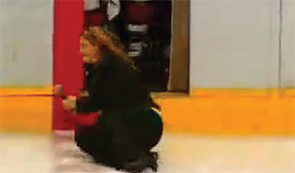In the first scenario, the woman is heckled, literally “booed,” then quickly shuffled off the ice rink after falling backwards on the ice. In the second scenario, a similarly talented young woman starts out strong, then forgets the words. An unrelated gentleman comes to her aid, puts his arm around her, and sings the words with her. As he continues, he looks to the audience, making hand signals to encourage them to join in supporting her during this presumably highly anxious moment.
The second scenario exemplifies all three components of compassion: The gentleman feels the singer’s anxiety, he acknowledges her “suffering,” and he is motivated to help. What I noticed about his assistance is that he is not even a very good singer! But his kind persuasion and ability to motivate the entire crowd in assisting her remarkably transform the outcome for both the singer and the crowd.
Though both scenarios start quite similarly, they end remarkably differently; the second scenario was completely changed by the compassion of a single person and a simple act of human kindness.
Why It Matters, and How to Build It
As depicted in these short videos, compassion can completely change outcomes. You will not find placebo-controlled randomized trials to support what I just stated. But there are plenty of social science studies to support the notion that compassion is a learned trait that can be improved or eroded over time, depending on the willingness of the person to try.
Compassion is a learned behavior. It is not a personality trait that you either have or you don’t. It is a set of behaviors and actions that can be learned and practiced, and even perfected, for those willing.
The Cleveland Clinic has created several videos (see video info box) that help us consider how to think about the nature of compassion and how to learn and practice it. A hospital is ripe with emotion in all areas, from the elevators to the hallways to the cafeteria. Due to the nature of our work, we are all at risk of compassion erosion toward our patients.
We first have to acknowledge such a risk is present and actively seek out opportunities, as depicted in these videos, to learn and practice compassion. As the Dalai Lama once said, “Compassion is a necessity, not a luxury.” We should all learn, demonstrate, and live compassion as a necessity in our practice.

Dr. Scheurer is a hospitalist and chief quality officer at the Medical University of South Carolina in Charleston. She is physician editor of The Hospitalist. Email her at [email protected].


I feel to be in the medical field you have to have compassion and empathy, patients come in to get help and sometimes doctors and nurses are all they have to talk to. I feel in this line of work we have to be all in, I know sometime taking on others buriden hurts but guess what if you can’t get your patient to talk to you about everything going on then how can you help then. I feel others pain and I don’t know how or why but I do and I can’t walk away without doing all I can to help them. Sometimes we just want a ear and sometimes we need to hear the true to help us better understand what we got going on so we can deal with it but without empathy and compassion how can you serve the public in a field so powerful.Our Doctors are a last line of defence and without them giving they all we fall.
It’s important to be compassion toward patients when being in the medical industry.you also got to have empathy towards patients,they need to know that we will help them in every way that we can do for them. I know the pain and suffering that they feel and i can relate to them. I believe by doing this the patient would open up to us. I feel if i can get them to open up and find that we are here for her. i can’t stand not doing every thing in my power to help them out, and help them get through it. I can not wait to get my degree . Then i can help people that are sad and confused. Patients need to know that we care, and that we will do are best to help them.
In the medical field I think well i know empathy and compassion is very important, yes i know that sometimes taking on others buriden can be a lot at times but we have to understand who and why the patient is number 1 and this field, our patients need to know and understand that we care and understand them. Sometimes they just need a ear and hand they can count on because they might don’t have anyone that cares for them, so its very important to gain the patients trust, letting them know I am also a friend, so they are able to tell you everything that’s going on with them because u build that trust bond with them. I love to help and make others smile and feel safe and comfortable speaking to me, I can’t walk away from my patients without knowing everything what’s going on with them and understanding why . The patients have to have a smile on they face before I or them walk away from me.
In the medical field, I believe that, I understand empathy quite well. You must have the ability, to see and understand others who are suffering. I have experienced this, through family members as well, who needed my care. Sometimes all it takes, is to put yourself, in your patients position. They want to be understood. They want to know you are there for them. They want to see, you understand, and even have compassion for them. I have a big heart. I always have. Since I was a child, I have wanted to help people. I don’t like it, when someone comes to me even now, and I cannot relate to what they are going through. I always have compassion. I always do whatever it takes, to try to understand where someone is coming from. Never pass judgement. Put yourself in that patient’s shoes. If you do all these things, you will realize that you will be a very wonderful heath care provider.